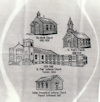Plumer Settlement
Oak Township, Mills County, Iowa
Salem Lutheran Church
"May it (Salem Church) become, for future visitors, a place of remembrance,
meditation, and respect." — Service of Re-dedication Bulletin,
September 22, 1956
1867 — The church is built
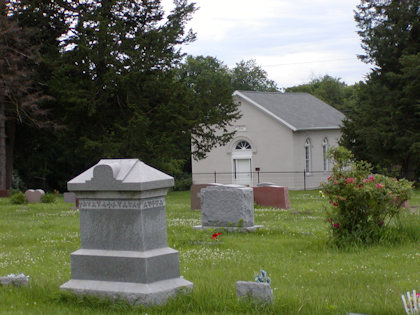 High on the bluffs east of the Missouri River, cradled in a heavily wooded highland, the pioneer Lutherans of Southwest Iowa built Salem Lutheran Church in 1867 at the Plumer Settlement in Mills County. Here
the forefathers of that faith in this area found strength and inspiration for their rugged existence. The official name of the church, as declared in their German-language constitution,
was "The Salem German Evangelical Lutheran Congregation of the
Unaltered Augsburg Confession in Plumer's Settlement in Mills and Pottawattamie County, Iowa."
High on the bluffs east of the Missouri River, cradled in a heavily wooded highland, the pioneer Lutherans of Southwest Iowa built Salem Lutheran Church in 1867 at the Plumer Settlement in Mills County. Here
the forefathers of that faith in this area found strength and inspiration for their rugged existence. The official name of the church, as declared in their German-language constitution,
was "The Salem German Evangelical Lutheran Congregation of the
Unaltered Augsburg Confession in Plumer's Settlement in Mills and Pottawattamie County, Iowa."
Prior to the organization of the church and cemetery, missionary ministers first held confirmation classes in the Plumer Schoolhouse. The young people of the classes were sent to board with the Plumer family or other neighbors to attend classes which were taught in their native German language. Weddings, baptisms and funerals were held in the homes before the church was built.
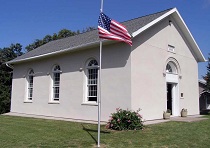
Mr. Plumer, along with Henry and Sophia (Plumer) Saar, were very influential in the building of the church. Henry and Sophia Saar donated the first $1,000 which was applied to the cost of the construction materials which were shipped by steamboat up the Missouri River.
The bricks were fired locally. Old timers once said that the first brick was laid by Ernest Kreft. Lumber for the building came from trees felled in the area. The church, which measures 29 x 40 feet, was built at a cost of $3,500.
Following completion of the construction of the church, the new home of the congregation was dedicated on Christmas, 1867, by the pastor, Karl Hoffmeister. Some of the pioneer families it served in 1867 were: Johann H. Plumer; Christopher, William, Henry F., and Frederick Plumer; Frederick Wilhelm Bichel; Henry and Sophia Saar; Charles and Julia Bauer Plumer Green; Henry Green and wife; H. Spetman; F. Spetman; F., H. Pusa; F. Spelling; John, Fred, Willhelm and Hans Schoening; Johann, Hans, and Henry Kruse; John Deutschler; Jacob Young; John Saar, C. (Christian) Beck; Jocham F. Mueller (Miller), Ernst Kreft, Rorberg, G. (George) Brandt, and; Stumpf.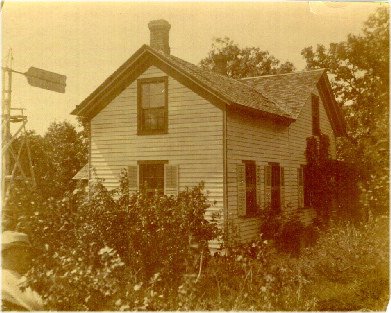
The first Pastor's House was built nearby in 1869 (see above left.).
early days of the "mother church"
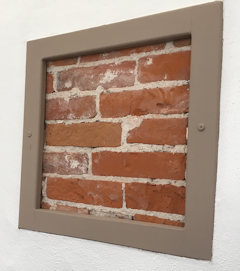
Salem is one of the oldest Iowa Lutheran Churches. In October 1880, the Western District of the Iowa Synod was organized in this church. It was known as the Mother Church of the Central District of the American Lutheran Church, from which some 100 Lutheran churches have stemmed, including those at Mineola and Treynor (Iowa).
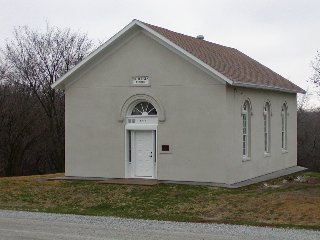
Originally built from locally fired bricks (photo, right), Salem Lutheran was once known as the "Little Brick Church". In 1900, the exterior was coated with cement for easier maintenance. It is now sometimes called "The Church of the Woods".
Salem Lutheran closes in 1933
In 1933, members of Salem Lutheran Church voted that the church be closed for services. Most members moved to Lutheran churches in Treynor or Mineola. During its history, Pastor H. E. Hoff had served for 33 years, followed by his son, Alfred Hoff, who served until the closing. Complete list of serving pastors
The 1956 restoration and commemoration
Badly in need of repair through neglect since 1933, and having been struck by lightning, restoration of the church was started in 1956.
Church and cemetery boards were selected to supervise the restoration. Members, friends and relatives of the original congregation, and members of neighboring churches contributed volunteer labor and funds.
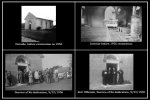
 ("Click" or "tap" thumbnail at left to see 1956 photos).
("Click" or "tap" thumbnail at left to see 1956 photos).

From the Service of Re-dedication bulletin: "May it (Salem Church) become, for future visitors, a place of remembrance, meditation, and respect."
The 2001 restoration
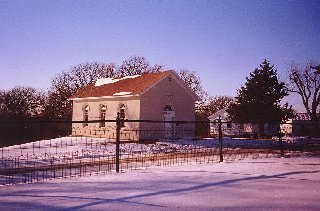 At 134 years of age, both the exterior and interior were in need of complete restoration. The Salem Lutheran
Association Church and Cemetery Board sought bids for the project and solicited monetary donations. Thanks to generous contributions, the exterior restoration was completed during the Fall of 2001. All bad spots were patched with fiber
stucco; the complete exterior was sprayed with 3/4" insulation type foam and bonded with fiberglass mesh; a base coat of cement and a finish coat of acrylic stucco were applied, and; new windows were installed. Most of the exterior
photos on this page were taken following the restoration, and show the new finish. Restoration of the interior of the building was completed during Winter/Spring of 2001-2002. Our church can continue standing stately and proud, as
a tribute to our ancestors and for future generations to come and visit.
At 134 years of age, both the exterior and interior were in need of complete restoration. The Salem Lutheran
Association Church and Cemetery Board sought bids for the project and solicited monetary donations. Thanks to generous contributions, the exterior restoration was completed during the Fall of 2001. All bad spots were patched with fiber
stucco; the complete exterior was sprayed with 3/4" insulation type foam and bonded with fiberglass mesh; a base coat of cement and a finish coat of acrylic stucco were applied, and; new windows were installed. Most of the exterior
photos on this page were taken following the restoration, and show the new finish. Restoration of the interior of the building was completed during Winter/Spring of 2001-2002. Our church can continue standing stately and proud, as
a tribute to our ancestors and for future generations to come and visit.
Salem Lutheran Church at Plumer Settlement is one of the oldest surviving churches in Western Iowa.
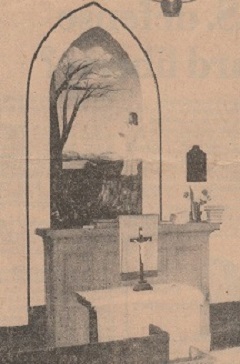
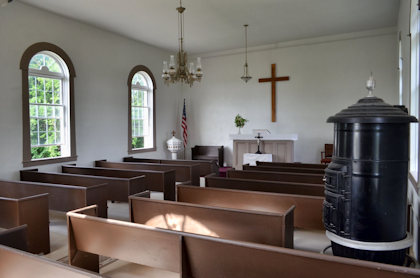
The painting shown at the left depicts “Christ Blessing the Farmlands”. The 8 by 4 foot painting (the artist and date are unknown) was once mounted in the arch behind the altar.
As seen in the interior photo on the right, the hand-hewn pews, kerosene chandelier, and crucifix are original furnishings. The large wood burning stove shown here is a replica of the original. The kerosene chandelier was given to the church by Mrs. Chris Plumer (Anna Schoening) in 1877.
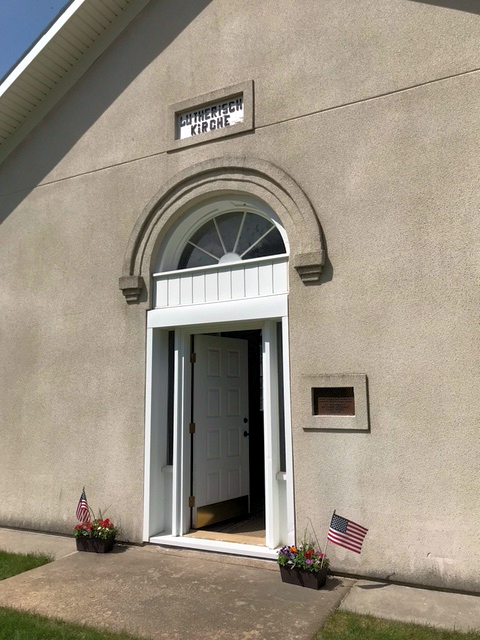
The annual memorial day service
Only one service a year is now held. At 10:00 a.m. each Memorial Day, descendents of the pioneers, and friends, gather at the church for a memorial service, and then cross the road for a brief ceremony at the Plumer Settlement Cemetery. Everyone is invited to attend this service and visitors are always welcome.
(Left photo of the church door and below photos of Salem sign courtesy of Randy Beck, taken on Memorial Day 2022. The sign is on display in the church. Click or tap the thumbnail photos below for more detail: the first shows a photo of the sign and men holding the sign; the second is the sign itself; the third shows the men holding the sign (note the names at the lower left); and the fourth shows detail and transcription of the names.)
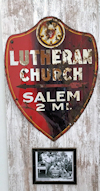
|
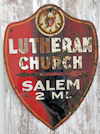
|

|

|
The cemetery
First burials in Plumer Settlement were made in Saar's Field until the cemetery across the road from Salem Lutheran Church was established between August 1872 and July 1874. The first burial at the Plumer Settlement Cemetery was of Maria Plumer, wife of John H. Plumer. She was born in 1796 and died on December 10, 1859. She had originally been buried in Saar's Field, but was later moved to the new cemetery.
The cemetery is well-kept. Many of the stones have German inscriptions. However, some limestone markers are difficult or impossible to read and others are broken or misplaced. Furthermore, there are no stones or markers on some of the lots.
More information about the Plumer Cemetery, including a list of burials and photos of many of the gravestones and memorials, can be found on the Cemetery page.
Church/Cemetery Records have been copied to microfilm. They can be viewed at the Pottawattamie County Genealogical Society in Council Bluffs, Iowa, or ordered from an LDS Family History Center. The Film Number is 2209255. The Church/Cemetery Records are also available online through Ancestry (paid subscription).
